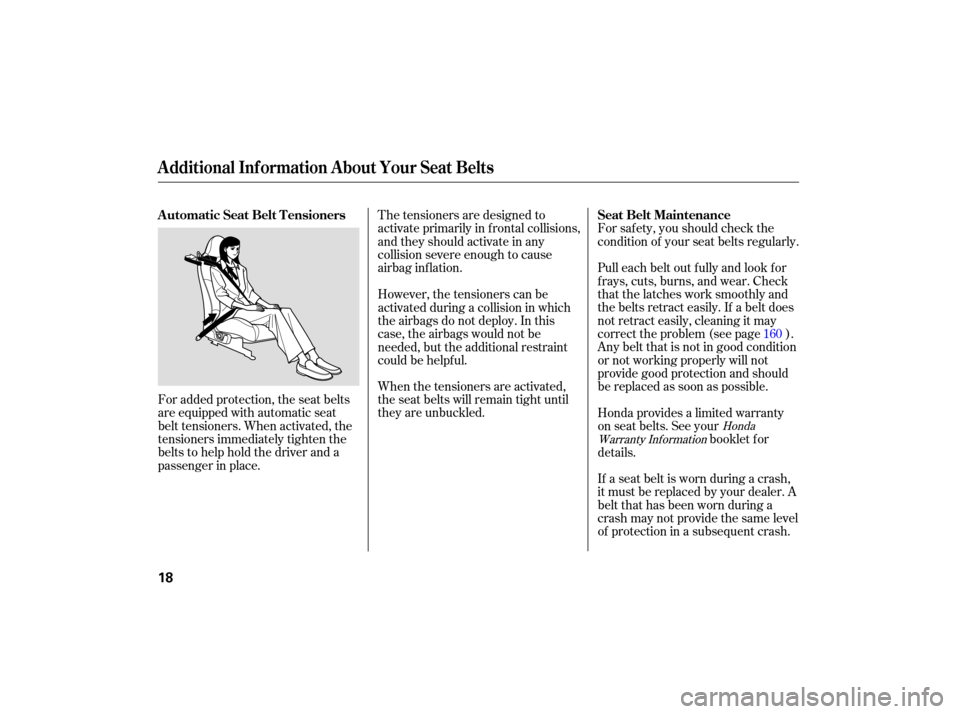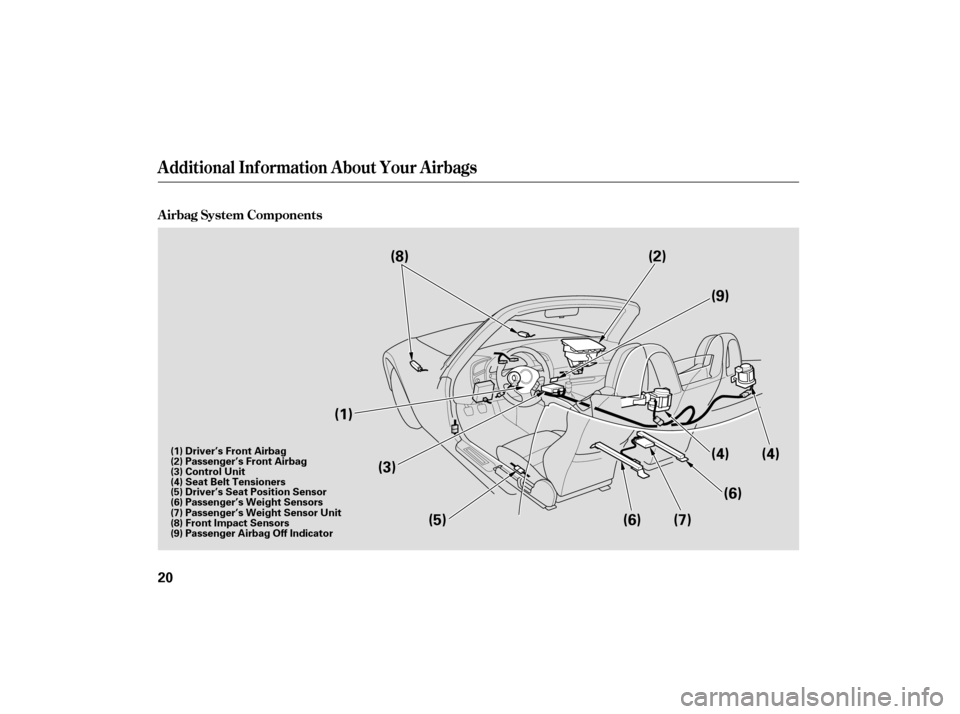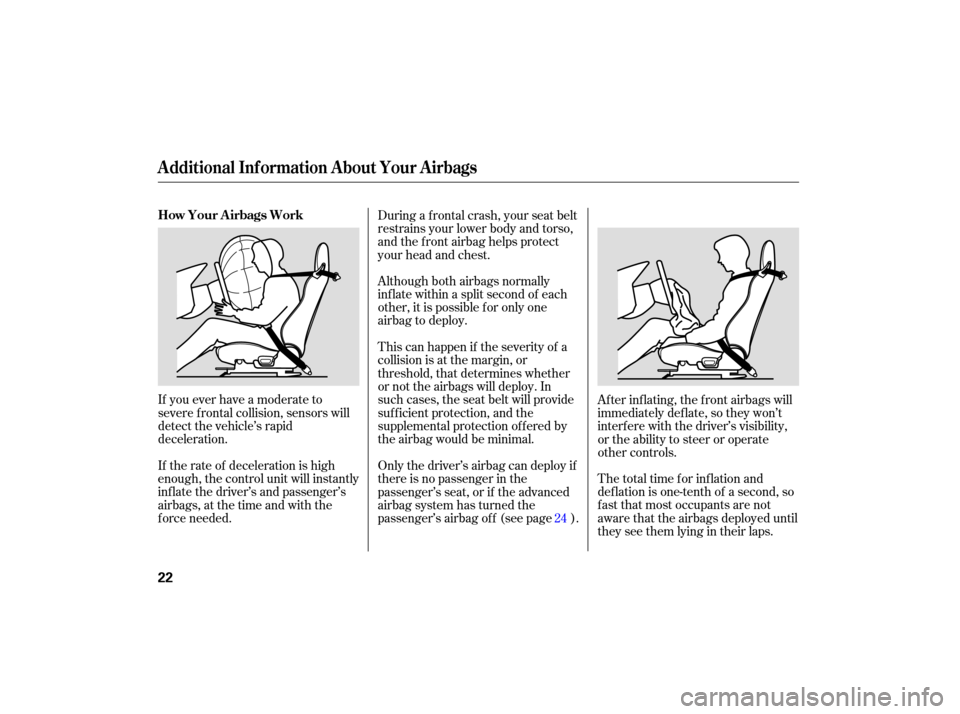HONDA S2000 2007 2.G Owner's Manual
Manufacturer: HONDA, Model Year: 2007, Model line: S2000, Model: HONDA S2000 2007 2.GPages: 228, PDF Size: 3.81 MB
Page 21 of 228

For safety, you should check the
condition of your seat belts regularly.
The
tensioners are designed to
activate primarily in frontal collisions,
andtheyshouldactivateinany
collision severe enough to cause
airbag inflation.
When the tensioners are activated,
the seat belts will remain tight until
th ey are unbuckl ed.
For
added protection, the seat belts
are equipped with automatic seat
belt tensioners. When activated, the
tensioners immediately tighten the
beltstohelpholdthedriveranda
passenger in place. Pull
each belt out fully and look for
frays, cuts, burns, and wear. Check
that the latches work smoothly and
the belts retract easily. If a belt does
not retract easily, cleaning it may
correct the problem (see page ).
Any belt that is not in good condition
or not working properly will not
provide good protection and should
be replaced as soon as possible.
If a seat belt is worn during a crash,
it must be replaced by your dealer. A
belt that has been worn during a
crash may not provide the same level
of protection in a subsequent crash. Honda provides a limited warranty
on seat belts. See your booklet f or
details.
However, the tensioners can be
activated during a collision in which
the airbags do not deploy. In this
case, the airbags would not be
needed, but the additional restraint
could be helpf ul.
160
Honda
Warranty Inf ormation
Seat Belt Maintenance
A utomatic Seat Belt T ensioners
Additional Inf ormation About Your Seat Belts
18
Page 22 of 228

The dealer should also inspect the
anchors f or damage and replace
them if needed. If the automatic seat
belt tensioners activate during a
crash, they must be replaced.
Additional Inf ormation About Your Seat Belts
Driver and Passenger Saf ety
19
Not checking or maintaining
seat belts can result in serious
injury or death if the seat belts
do not work properly when
needed.
Check your seat belts regularly
and have any problem
corrected as soon as possible.
Page 23 of 228

A irbag System Components
Additional Inf ormation About Your Airbags
20
(1)(2)
(3) (7)
(8)
(6)
(4)
(5) (4)
(6) (9)
(5) Driver’s Seat Position Sensor
(6) Passenger’s Weight Sensors
(7) Passenger’s Weight Sensor Unit
(8) Front Impact Sensors
(9) Passenger Airbag Off Indicator (1) Driver’s Front Airbag
(2) Passenger’s Front Airbag
(3) Control Unit
(4) Seat Belt Tensioners
Page 24 of 228

Emergency backup power in case
your vehicle’s electrical system is
disconnected in a crash.
Your
airbag system includes: An indicator on the dashboard that
alerts you that the passenger’s
airbag has been turned off (see
page ).
Automatic seat belt tensioners
(see page ).
Sensors that can detect a
moderate to severe front impact.
Sensors that can detect whether
the driver’s seat belt and the
passenger’s seat belt are latched
or unlatch ed (see page ). A
sophisticated electronic system
that continually monitors and
reco rds information about the
sensors, the control unit, the
airbag activators, the seat belt
tensioners, and driver and
passenger seat belt use when the
ignition switch is in the ON (II)
position.
An indicator on the instrument
panel that alerts you to a possible
problem with your airbags,
sensors, or seat belt tensioners
(see page ).
A
driver’s seat position sensor that
monitors the distance of the seat
from the airbag. If the seat is too
far forward, the airbag will inflate
with less force (see page ). Weight
sensors that monitor the
weight on the passenger’s seat. If
the weight is about 65 lbs (29 kg)
or less (the weight of an infant or
small child), the passenger’s
airbag will be turned off (see page
).
Two SRS (supplemental restraint
system) airbags. The driver’s
airbag is stored in the center of
the steering wheel; the passenger’s
airbag is stored in the dashboard.
Both are marked ‘‘SRS AIRBAG.’’ 26
16
18
24
25
24
Additional Inf ormation About Your Airbags
Driver and Passenger Saf ety
21
Page 25 of 228

The total time for inflation and
defl ation is one-tenth of a second, so
fast that most occupants are not
aware that the airbags deployed until
they see them lying in their laps.
Al
though both airbags normally
inflate within a split second of each
other, it is possible for only one
airbag to deploy.
This can happen if the severity of a
collision is at the margin, or
threshold, that determines whether
or not the airb ags will deploy. In
such cases, the seat belt will provide
sufficient protection, and the
supplemental protection offered by
the airbag would be minimal.
If
you ever have a moderate to
severe frontal collision, sensors will
detect the vehicle’s rapid
deceleration.
If the rate of deceleration is high
enough, the control unit will instantly
inflate the driv er’s and passenger’s
airbags, at the time and with the
force needed. Only
the driver’s airbag can deploy if
there is no passenger in the
passenger’s seat, or if the advanced
airbag system has turned the
passenger’s airbag of f (see page ). During a f rontal crash, your seat belt
restrains your lower body and torso,
and the f ront airbag helps protect
your head and chest.
Af ter inf lating, the f ront airbags will
immediately def late, so they won’t
interf ere with the driver’s visibility,
or the ability to steer or operate
other controls.
24
Additional Inf ormation About Your Airbags
How Your Airbags Work
22
Page 26 of 228

In acrash, both stages
will ignite simultaneously to provide
the quickest and greatest protection.
In a crash, one stage will
ignite first, then the second stage
will ignite a split second later. This
provides longer airbag inf lation time
with a little less force.
After a crash, you may see what
looks like smoke. This is actually
powder f rom the airbag’s surf ace.
Although the powder is not harmf ul,
people with respiratory problems
mayexperiencesometemporary
discomf ort. If this occurs, get out of
the vehicle as soon as it is saf e to do
so.
Your f ront airbags are dual-stage
airbags. This means they have two
inf lation stages that can be ignited
sequentially or simultaneously,
depending on crash severity.
Your f ront airbags are also dual-
threshold airbags. Airbags with this
f eature have two deployment
thresholds that depend on whether
sensors detect the occupant is
wearing a seat belt or not.
If the occupant’s belt is
,
the airbag will deploy at a slightly
lower threshold, because the
occupant would need extra
protection.
If the occupant’s belt , the
airbag will inf late at a slightly higher
threshold, when the airbag would be
needed to supplement the protection
provided by the seat belt.
Dual-T hreshold A irbags
Dual-Stage A irbags
more severeless severe not lat ched
is latched
Additional Inf ormation About Your Airbags
Driver and Passenger Saf ety
23
Page 27 of 228

If there is a problem with the sensor,
the SRS indicator will come on, and
the airbag will inf late in the normal
manner regardless of the driver’s
seating position.
Your airbags are also advanced
airbags. The main purpose of this
feature is to help prevent airbag-
caused injuries to short drivers and
children who ride in the passenger’s
seat.
For both advanced airbags to work
properly:
Occupants must sit upright and
wear their seat belts properly.
Failure to f ollow these instructions
could damage the sensors or prevent
them f rom working properly. Do not spill any liquids on or
under the seats, cover the sensors,
or put any objects or metal items
under the seats.
The driver’s advanced front airbag
system includes a seat position
sensor under the seat. If the seat is
too far forward, the airbag will
inf late with less f orce, regardless of
the severity of the impact.
Be aware that objects placed on the
passenger’s seat can also cause the
airbag to be turned off. The passenger’s advanced airbag
system has weight sensors under the
seat. Although Honda does not
encourage carrying a child in the
passenger’s seat, if the sensors
detect the weight of an inf ant or
small child (up to about 65 lbs or 29
kg), the system will automatically
turn the passenger’s airbag of f .
Advanced Airbags
Additional Inf ormation About Your Airbags
24
DRIVER’S
SEAT
POSITION
SENSORPASSENGER’S
SEAT WEIGHT
SENSOR
Page 28 of 228

CONTINUED
When you turn the ignition switch to
the ON (II) position, this indicator
comes on briefly then goes off. This
tells you the system is wo rking
properly.
If the indicator comes on at any
other time, or does not come on at all,
you should have the system checked
by your dealer. For example:
If the SRS indicator does not come
on after you turn the ignition
switch to the ON (II) position.
Wh
en the airbag is turned off, a
‘‘passenger airbag off’’ indicator in
the center of the dashboard comes
on (see page ).
If the indicator stays on after the
engine starts.
If the indicator comes on or
flashesonandoff whileyoudrive.The SRS indicator alerts
you to a potential problem
with your airbags or seat belt
tensioners.
If the weight sensors detect there is
no passenger in the seat, the airbag
will be of f . However, the passenger
airbag of f indicator will not come on. To ensure that the passenger’s
advanced airbag system will work
properly,
26
Additional Inf ormation About Your Airbags
How the SRS Indicator Works
do not do anyt hing t hat
would increase or decrease t he weight on the passenger’s seat, suchas hanging heavy objects on the seat.Driver and Passenger Saf ety
25
Page 29 of 228

If you see any of these indications,
the airbags and seat belt tensioners
may not work properly when you
need them.Be aware that objects placed on the
passenger’s seat can cause the
indicator to come on.
If no weight is detected on the
passenger’s seat, the airbag will be
automatically shut off. However, the
indicator will not come on.
This indicator alerts you that the
passenger’s airbag has been shut of f
because weight sensors detect about
65 lbs (29 kg) or less (the weight of
an inf ant or small child) on the
passenger’s seat. It does
there is a problem with the airbag. How the Passenger Airbag Of f
Indicator Works
Additional Inf ormation About Your Airbags
not mean
26
PASSENGER AIRBAG OFF INDICATOR U. S. Canada
Ignoring the SRS indicator can
result in serious injury or death
if the airbag systems or
tensioners do not work properly.
Have your vehicle checked by a
dealer as soon as possible if
the SRS indicator alerts you to
a possible problem.
Page 30 of 228

The passenger airbag of f indicator
maycomeonandoff repeatedlyif
the total weight on the seat is near
the airbag cutof f threshold.If the indicator comes on with no
passenger and no objects on the
passenger seat, or with an adult
riding there, something may be
interf ering with the weight sensors.
Look f or and remove:
Any items under the passenger’s
seat.
Any objects hanging on the seat.
Any object touching the rear of
the seat-back.
If no obstructions are f ound, have
your vehicle checked by a dealer as
soon as possible. Do not try to remove or replace
anyairbagbyyourself.Thismust
be done by an authorized dealer or
a knowledgeable body shop.Any airbag
that has deployed must be
replaced along with the control
unit and other related parts. Any
seat belt tensioner that activates
must also be replaced.
Your airbag systems are virtually
maintenance f ree, and there are no
parts you can saf ely service.
However, you must have your
vehicle serviced if:
If this happens, adjust the seat as f ar
to the rear as possible and have the
passenger sit upright and wear the
seat belt properly.
An airbag ever inf lates.
Airbag Service
Additional Inf ormation About Your Airbags
Driver and Passenger Saf ety
27